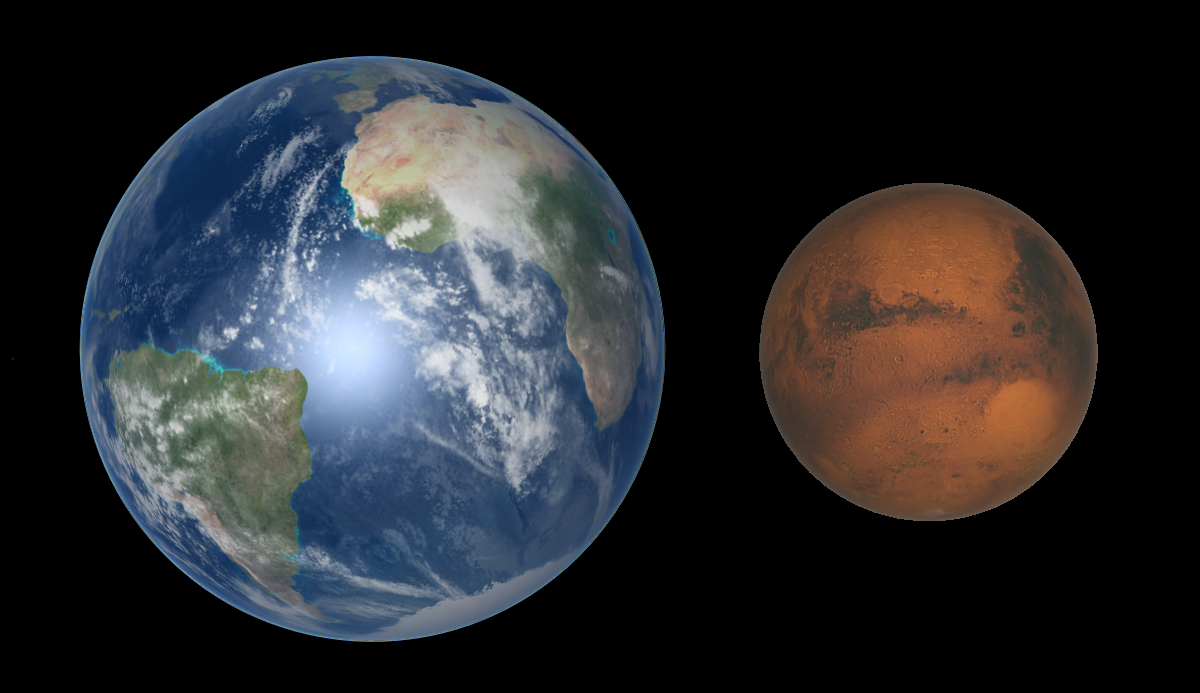
 Copyright © Michael Richmond.
This work is licensed under a Creative Commons License.
Copyright © Michael Richmond.
This work is licensed under a Creative Commons License.
Mars is smaller than the Earth, both in size and in mass:

Earth Mars
--------------------------------------------------
Radius 6.37 x 106 3.40 x 106
Mass 5.97 x 1024 6.42 x 1023
--------------------------------------------------
By the way, how do we know the mass of Mars? Perhaps this picture might give you a hint. Thanks to ESA/DLR/FUBerlin/AndreaLuck
The surface gravity of a planet depends on both the planet's mass and radius. More mass should lead to a stronger surface gravity -- so one might guess that Mars will have a smaller value. But being closer to the center of the planet should also yield a larger surface gravity -- which favors Mars over the Earth. Which factor is more important?
Well, the surface gravity can be calculated via

where G = 6.67 x 10-11 N*kg2/m2.
Q: What is the surface gravity of Earth? Q: What is the surface gravity of Mars? Q: How would it feel to walk on the surface of Mars?
Now, that formula for surface gravity might look familiar. It involves the same terms -- mass of a planet, radius of a planet -- we used earlier to compute the escape velocity from a planet. Since we have all the numbers at hand, let's calculate the escape velocity from Earth and Mars, too.

Q: Would it be easier or harder for a rocket launched from
the surface to escape from Mars, compared to the Earth?
So, if it's easier for a rocket to escape from Mars, would the same be true for an atmosphere?
Q: Besides escape velocity, what are the factors which affect
the fate of an atmosphere around a planet?
As you should recall, the fate of an atmosphere depends on the relative sizes of the planet's escape speed and typical molecular speed. And the speed of molecules in a gas depends on two factors:
One can use the following simplified formula to compute the typical speed of molecules in a gas:

So, work out those numbers! Recall that the main constituent of the martian atmosphere is carbon dioxide, which makes up roughly 95% of the gas.
Q: What is the escape speed from Mars?
Q: What is the typical speed of CO2 in the martian atmosphere?
Q: So ... what is the fate of carbon dioxide around Mars?
( Hint, hint)
Phew. In good news for the Martians, and for any Earthlings who may visit Mars in the future, Mars does have a strong enough gravitational field to retain its atmosphere over very long periods.
But is that atmosphere useful? By which, of course, I mean "useful to any humans who might be visiting?"
Well, there's Good News and Bad News in the answer to that question. Let's start with the Bad News.
No, you can't breathe it (and live)
Why not? Take a look at an atmosphere that we CAN breathe: that of the Earth. Below is a graph illustrating some properties of the Earth's atmosphere as a function of altitude above the surface. Note how the pressure drops rather sharply with altitude above the surface.
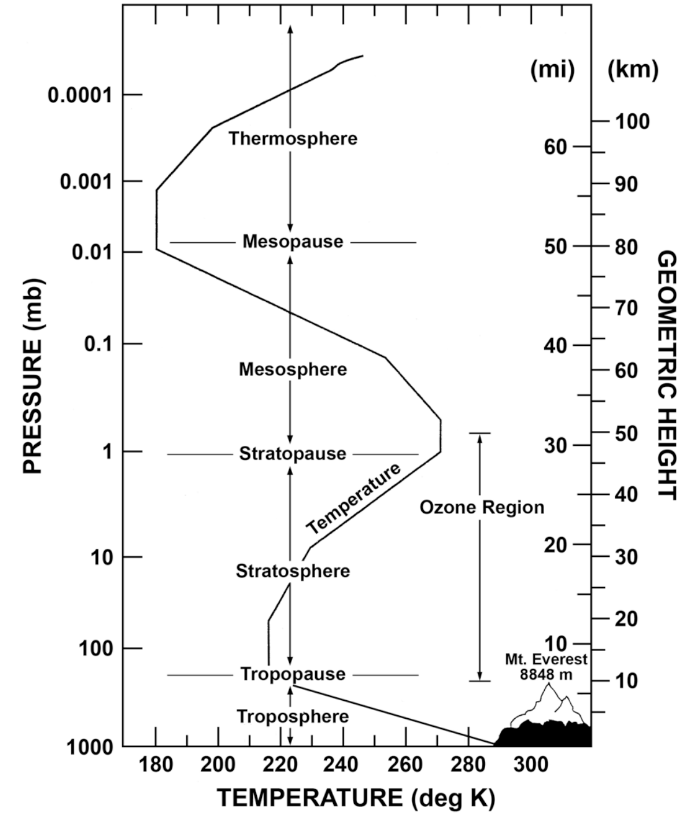
Image courtesy of
Amanda Staderman, Lunar and Planetary Lab, University of Arizona
based on information in
"US Standard Atmosphere", NOAO, NASA, USAF (1976)
Q: How high can humans climb (or fly) before breathing
becomes difficult?
A few -- a very few -- highly trained humans in the primes of their lives have climbed Mount Everest and similar mountains without oxygen. Many more have tried and failed. It's fair to put the limit of short-term human existence around 8000 or 9000 meters.
The atmosphere of Mars is much thinner than that of the Earth, of course. Just how high would one have to climb in the Earth's atmosphere to reach the same pressure as that on the surface of Mars?
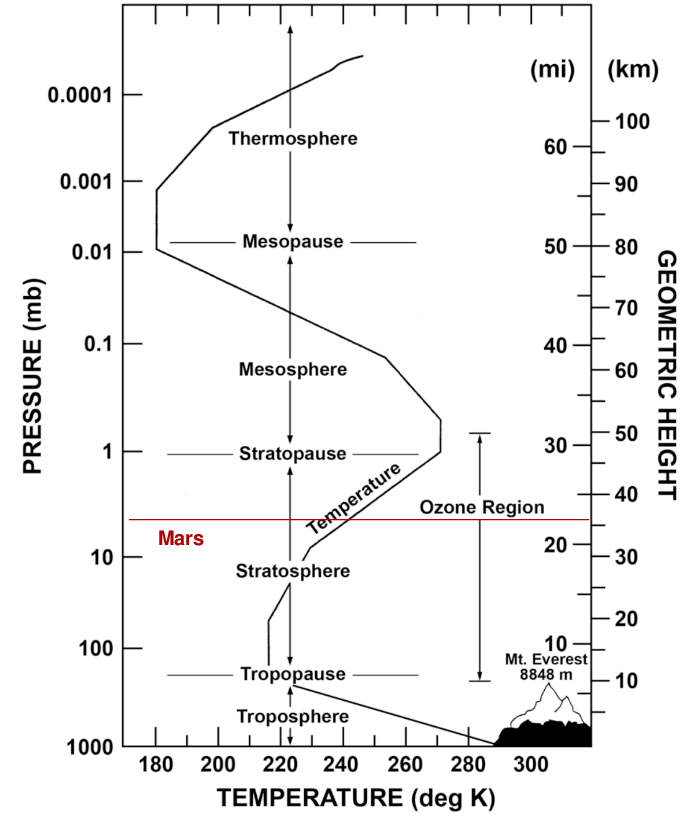
Image courtesy of
Amanda Staderman, Lunar and Planetary Lab, University of Arizona
based on information in
"US Standard Atmosphere", NOAO, NASA, USAF (1976)
Q: What would happen to a person at this altitude in the
Earth's atmosphere? Hint: this is roughly twice
the altitude of commercial airliners.
But wait -- it gets worse! The critical material for humans is oxygen. On Earth, O2 makes up 21 percent of the air; but on Mars, only about 0.13 percent of the atmosphere is O2. That means that the partial pressure of atmosphere -- a measure of the amount actually reaching one's lungs when one breathes -- would be smaller still.
To a rough approximation, the partial pressure of oxygen near the surface of Mars would be equivalent to that in the Earth's atmosphere at ... a higher altitude.
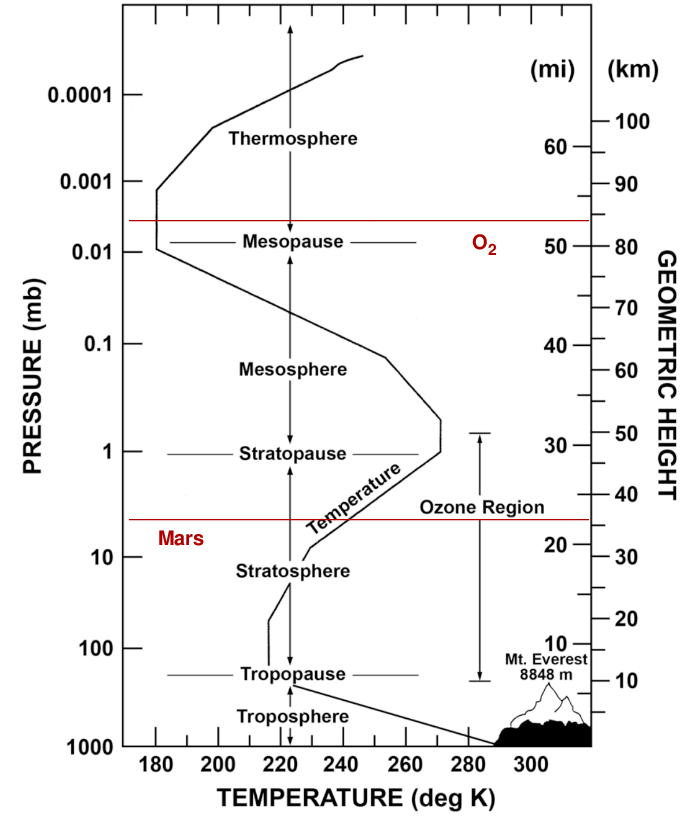
Image courtesy of
Amanda Staderman, Lunar and Planetary Lab, University of Arizona
based on information in
"US Standard Atmosphere", NOAO, NASA, USAF (1976)
But there's also some Good News -- the atmosphere, thin as it is, provides some benefits.
Who cares about little bits of rock and dust? You should! Since the Earth's sweeps through its orbit at v = 30,000 m/s, it smashes into those grains -- or they smash into the Earth -- at very high speeds. At such speeds, the kinetic energy of even a tiny little grain of sand, 0.5 mm in diameter, is ... considerable.
grain of sand 115-grain bullet
colliding with Earth fired from Glock
-----------------------------------------------------------------
mass 0.17 mg 7.5 g
speed 30,000 m/s 380 m/s
kinetic energy 78 J 540 J
-----------------------------------------------------------------
Fortunately, above our heads is air -- quite a LOT of air. Above each square meter of the Earth lie roughly 10,000 kg of nitrogen and oxygen molecules. When tiny meteors strike this blanket of air, they burn up long before reaching the ground.

Image of Geminids over Heilongjiang Province copyright
Jeff Dai and
The World at Night
While the atmosphere of Mars is considerably thinner than that of Earth, it still contains quite a bit of mass: roughly 172 kg over each square meter. Since the great majority of meteors are the very very small ones, that's still enough mass to stop most of the incoming objects.
On Earth, the atmosphere also does a good job of blocking ultraviolet radiation, which can do much worse than give a sunburn.

Graph taken from
Diffey, "Solar ultraviolet radiation effects on biological systems",
Physics in Medicine and Biology, 36, 299 (1990)
The atmosphere of Mars does block the very short wavelength UV radiation, but allows quite a bit of light with wavelengths below 300 nm to reach the surface.
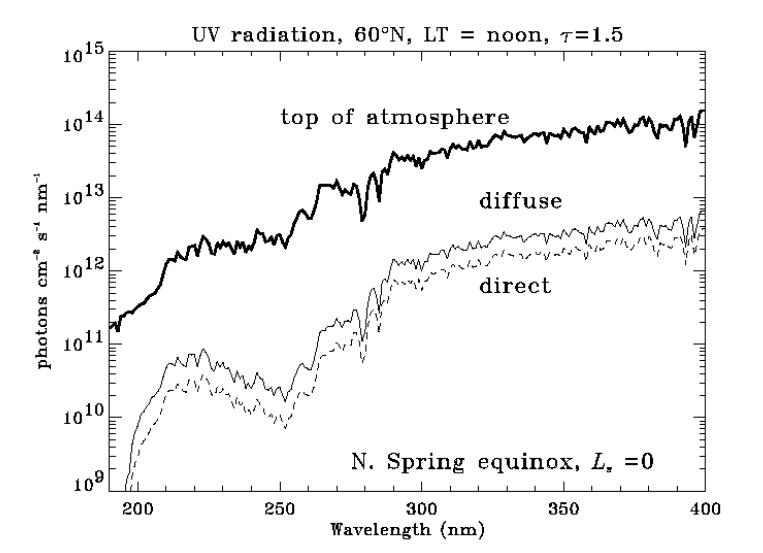
Graph taken from
Catling et al. (2018).
Since Mars is farther from the Sun than the Earth, it ought to be colder. That could make visitors from Earth quite uncomfortable.
Remember the greenhouse effect? It has increased the temperature of Venus by over 300 Kelvin and the temperature of the Earth by 15 - 30 Kelvin. Does it have any effect on the temperature of Mars?
Let's find out. First, we'll compute the expected temperature of Mars, assuming it were a perfect airless blackbody and ignoring rotational effects. The semi-major axis of Mars' orbit is 1.52 AU.

Q: What is the expected temperature for Mars?
Mars, like Earth, experiences day-night cycles in temperature, and it also has seasons. So the "average" temperature of Mars is (like that of Earth) somewhat hard to determine. Below are measurements over a few days made by two different landers: Viking 1 and Mars Pathfinder. The measurements shown were taken years apart, but during the same season: the height of martian summer.

Graph courtesy of
Weather Reports from Mars and NASA
Q: How do these temperature compare to the expected value?
Q: How would YOU feel if you were standing on Mars?
Hmmm. The expected value, 227 Kelvin, falls right in the middle of these daily excursions ... in the middle of summer. If there is any greenhouse effect, it's pretty small. Haberle (Icarus, 233, 619, 2013) does a real calculation and finds that it yields the same qualititive result as this very simplistic approach: the greenhouse effect may add 5 degrees to the planet's temperature.
The atmosphere does provide another small benefit: it can transfer heat from the daytime-side of the planet to the night-time side, and thus moderate daily swings in temperature. They remain pretty large, though: The Viking 1 measurements shown above indicate a change of roughly 60 degrees Celsius, which is over 100 degrees Fahrenheit!
Thanks to a number of spacecraft which have orbited Mars over the past 42 years, we have excellent images of the entire surface of the planet. In fact, since there are few clouds and no vegetation, we probably have a better view of some regions of Mars than we do of some regions of the Earth.
Take a look at the mosaic below, constructed from images taken by the Mars Global Surveyor.
Write down at least 3 conclusions you can draw
about the planet, based on this map.
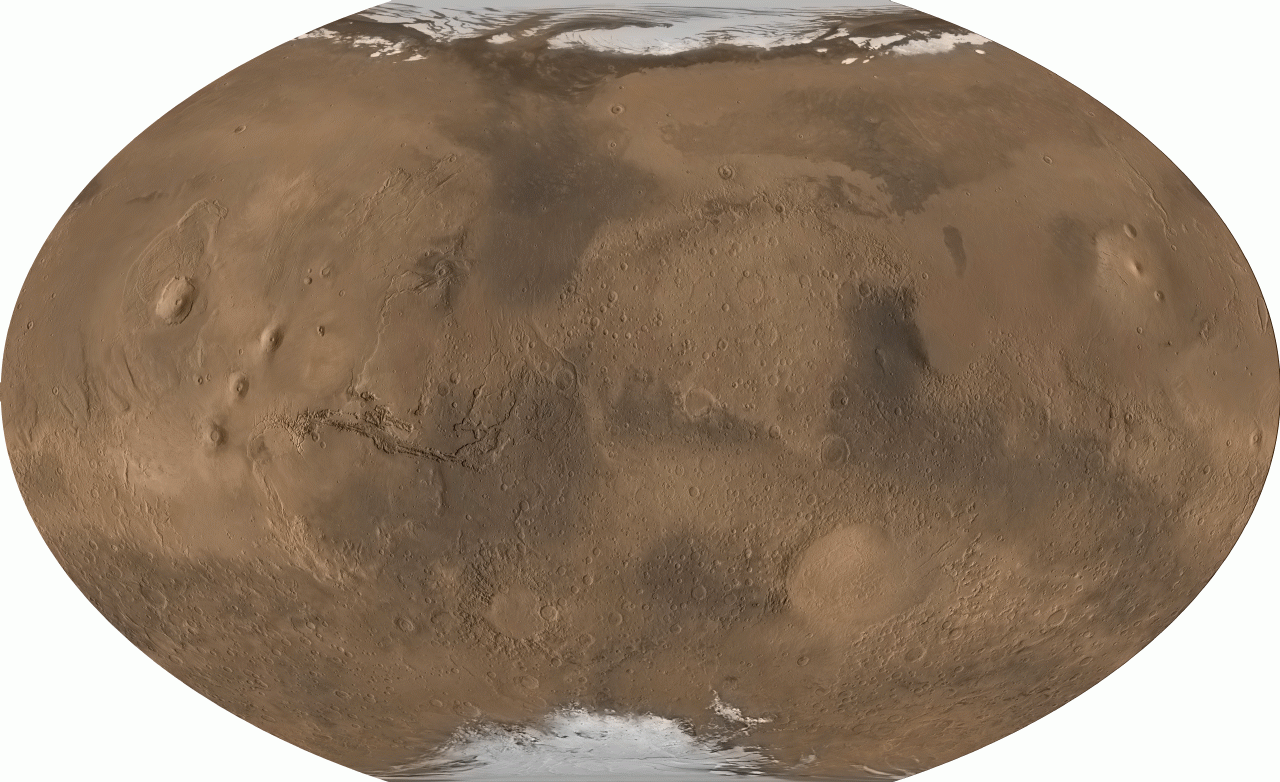
Image courtesy of
National Geographic Society, MOLA Science Team, MSS, JPL, NASA.
One of the most obvious large-scale features is the difference between the northern and southern hemispheres:
This dichotomy is even more obvious if one measures the ALTITUDE of each piece of the surface, using a laser altimeter (similar in concept to the radar altimeter used by Pioneer Venus ). On the maps below, blue colors denote regions lower than the mean surface level, and red indicates regions which are higher.
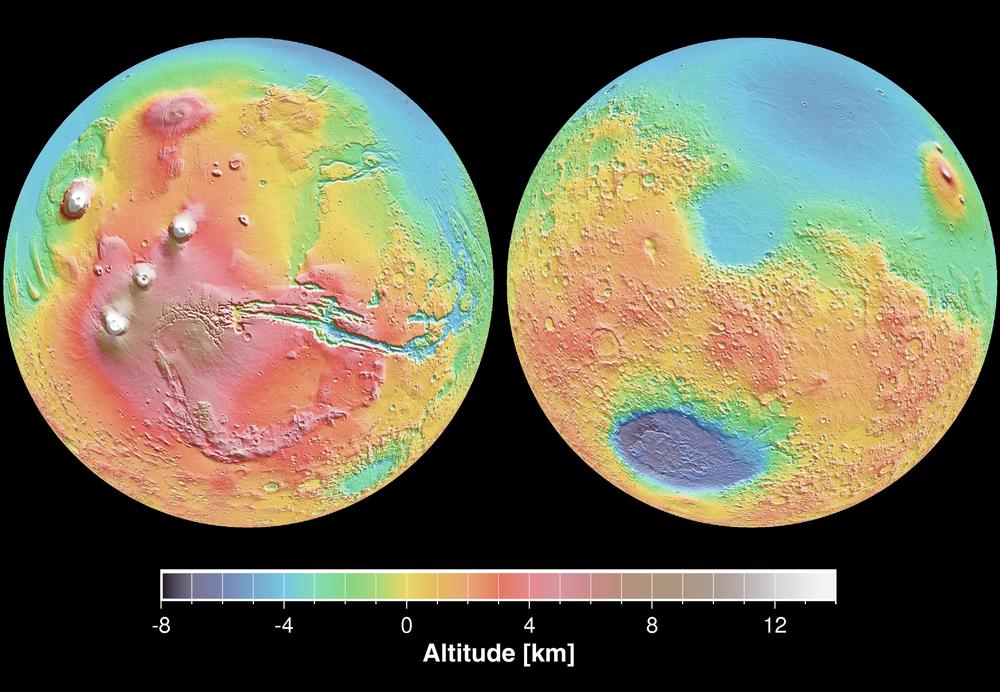
Image based on Mars Orbiter Laser Altimeter (MOLA)
courtesy of
The Center for Planetary Science

Map courtesy of
NASA / JPL / GSFC and
Emily Lakdawalla
Mars seems to have two very different halves, the southern highlands and the northern lowlands.
Q: What might we conclude about the relative ages of
the two hemispheres?
By this time, you know one way to estimate the age of a planetary surface: count craters, and compare the distribution of craters of different sizes to surfaces with known ages. Thanks to the many spacecraft which have flown past and around the planet, we have excellent maps of the entire surface. What do they tell us?
Well, by looking at the RELATIVE NUMBERS of large, medium, and small craters, we can estimate the ages of particular regions on the surface.
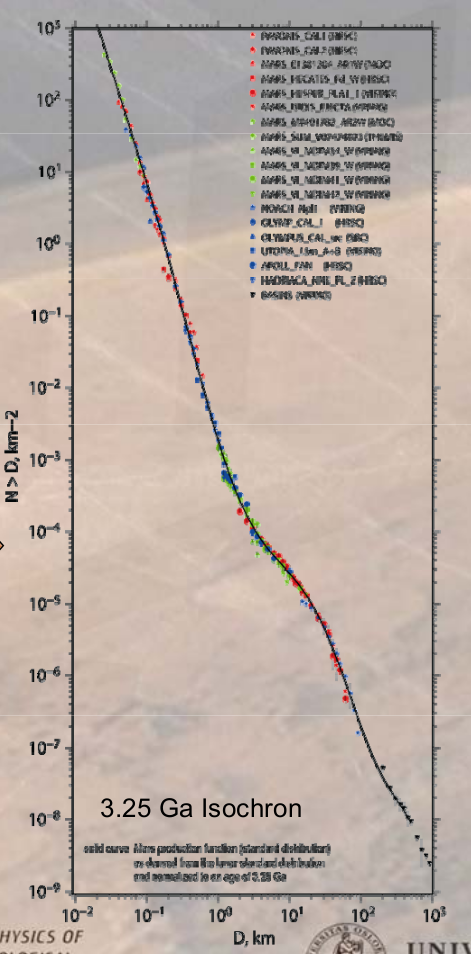
Taken from
a presentation by Stephanie Warner (2010)
But there's another way to look at crater counts. If one counts the ABSOLUTE NUMBER of craters within a certain range of sizes, then there's a similar relationship between number and age: again, more craters means an older surface.
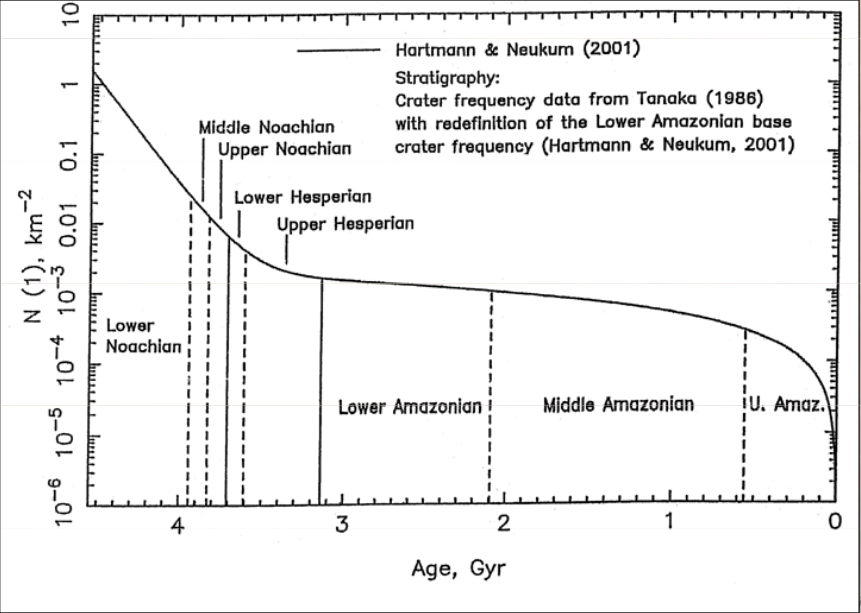
Taken from
a presentation by Stephanie Warner (2010)
What are all those names? Well, perhaps you may have seen diagrams like this in books describing dinosaurs (I surely did!):
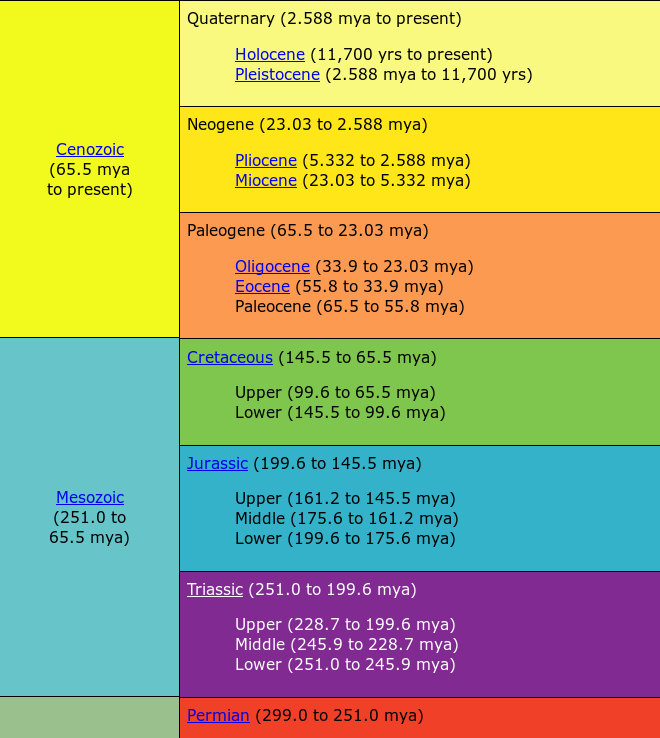
Table (slightly modified) courtesy of
University of California Museum of Paleontology
The names "Cenozoic", "Mesozoic", "Jurassic", and so forth, denote large chunks of time in the Earth's history. Humans have studied the abundant rocks on Earth for centuries, so we've been able to divide the entire history of the Earth into many, many periods. But we have comparatively little information about Mars, so there are only a few, very long, periods.

Taken from
a presentation by Stephanie Warner (2010)
Planetary geologists who study Mars have been able to figure out roughly which sort of physical processes were most active during these broad stretches of time. Note the key at the bottom of the table below.
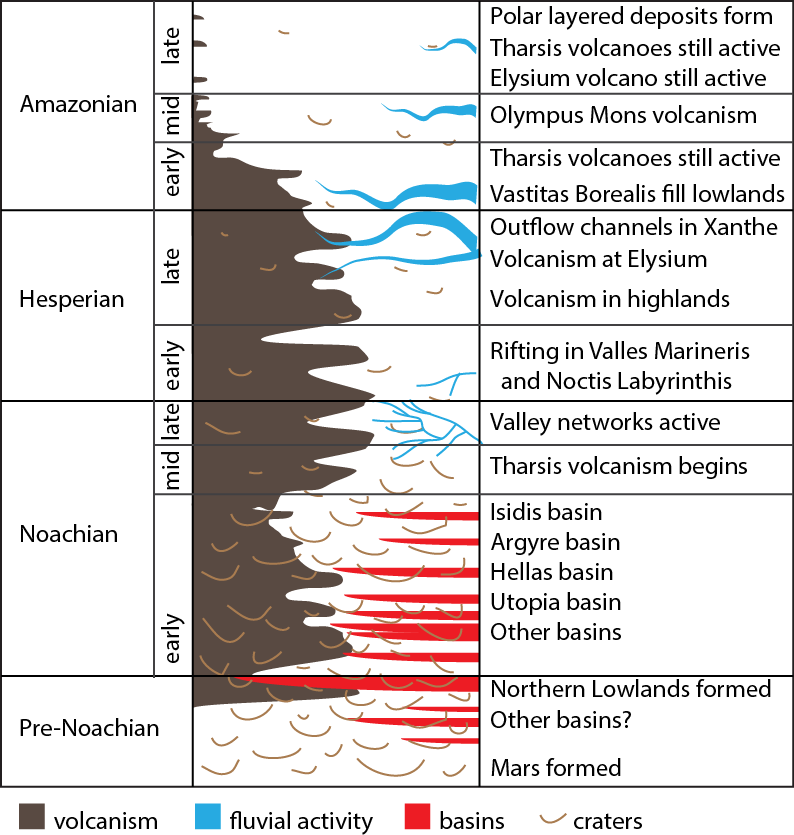
Image courtesy of
Emily Lakdawalla
after Tanaka and Hartmann (2012)

Map courtesy of
NASA / JPL / GSFC and
Emily Lakdawalla
One of the features -- perhaps THE FEATURE -- of Mars which makes it so interesting and exciting to scientists and the general public alike is the presence of water. Water is a major, required component of all life on Earth, and so it's reasonable to look for traces of life elsewhere in the universe which shows signs of water. And Mars shows many such signs.
First, and perhaps most obvious, are the polar caps. One can see them clearly even from ground-based telescopes, with nothing more sophisticated than the human eye.
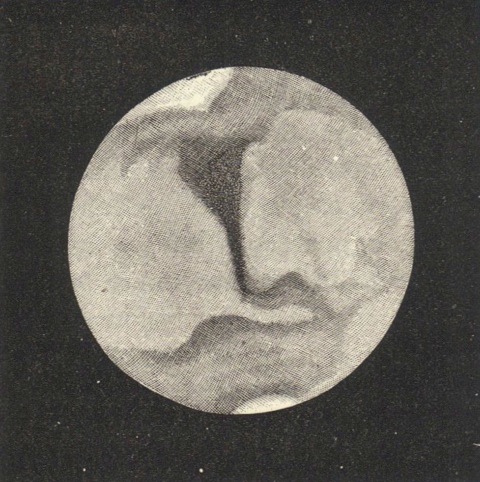
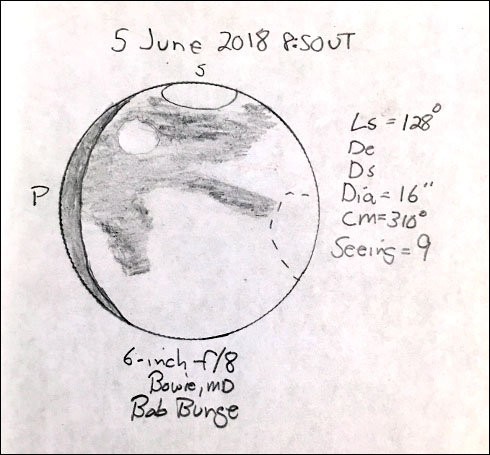
(Left) Drawing of Mars made Apr 20, 1856, courtesy of
The Gallery of Natural Phenomena ;
(Right) Drawing of Mars made June 5, 2018,
by Robert Bunge,
courtesy of
Sky and Telescope magazine
Visual observers noted changes in the polar caps over time: they grew and shrank with the seasons. Modern instruments show the same changes:
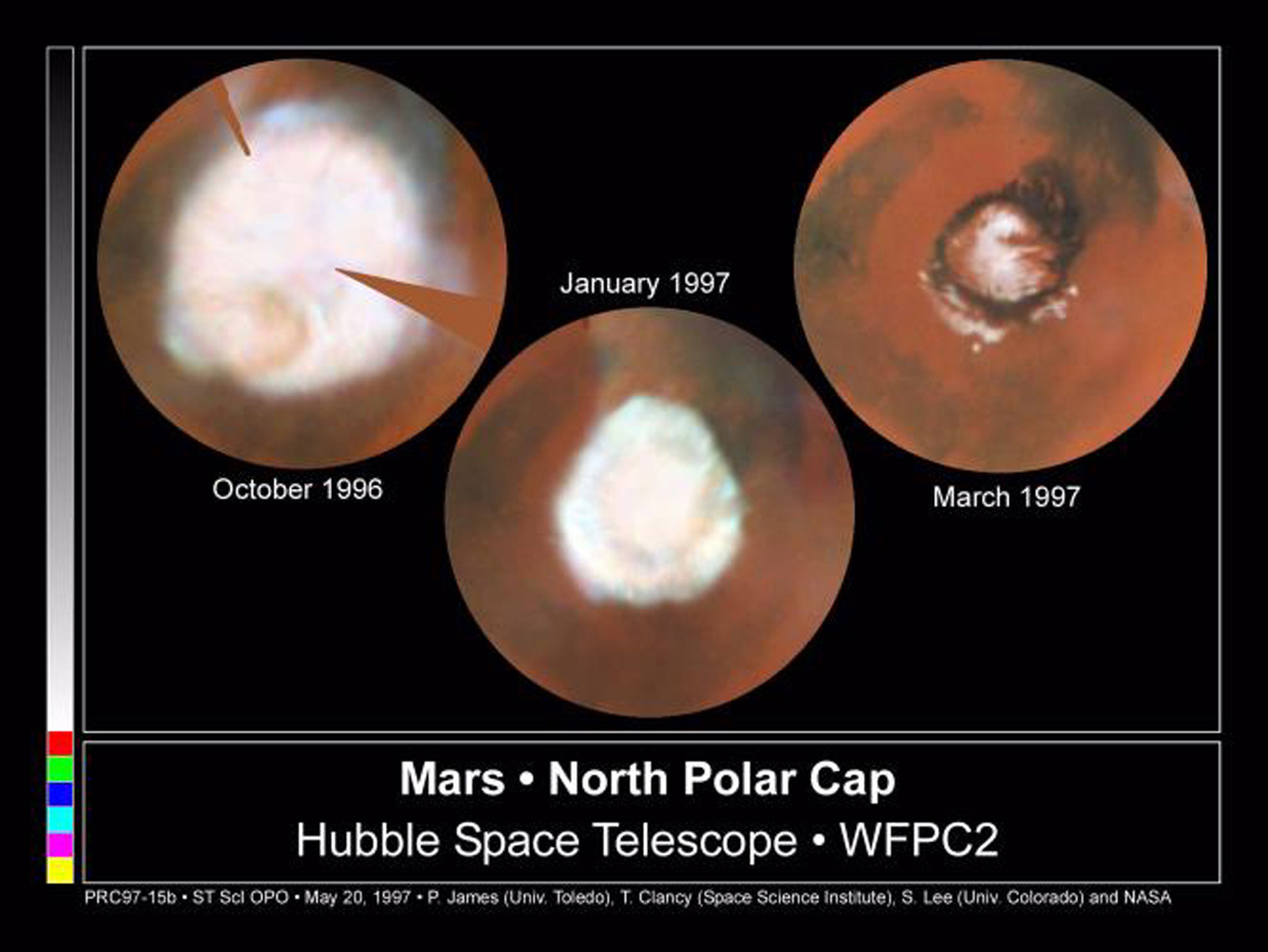
Image courtesy of
JPL/NASA/STScI
The current understanding is that the northern cap contains a "core" of water ice, which is usually covered by a layer of frozen carbon dioxide. It is only during the northern hemisphere's summer that all the CO2 sublimates, leaving behind a relatively small amount of water ice.
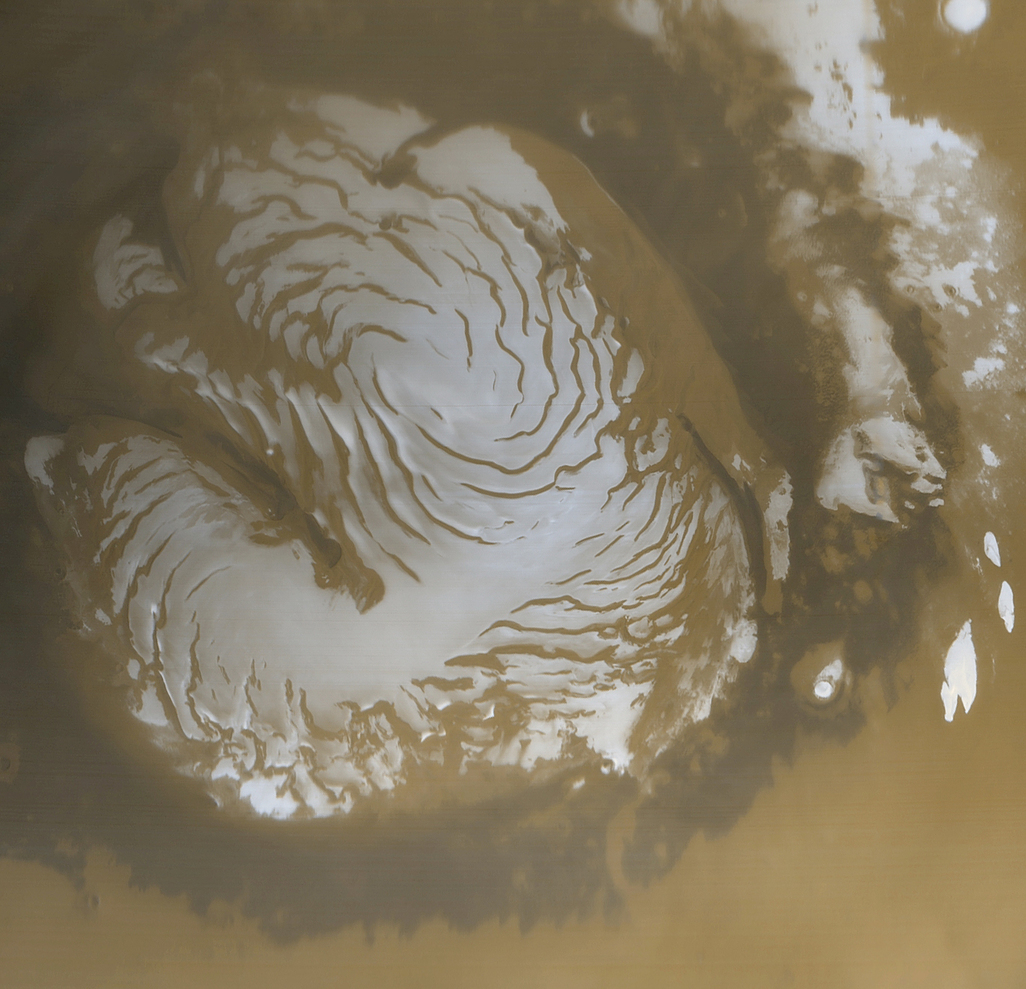
Image courtesy of
NASA/JPL/Malin Space Science Systems
The second clue that water exists -- or existed -- on Mars are the many surface features which look just like river channels and sinuous trenches created by water on Earth. I'll provide just a few examples below.
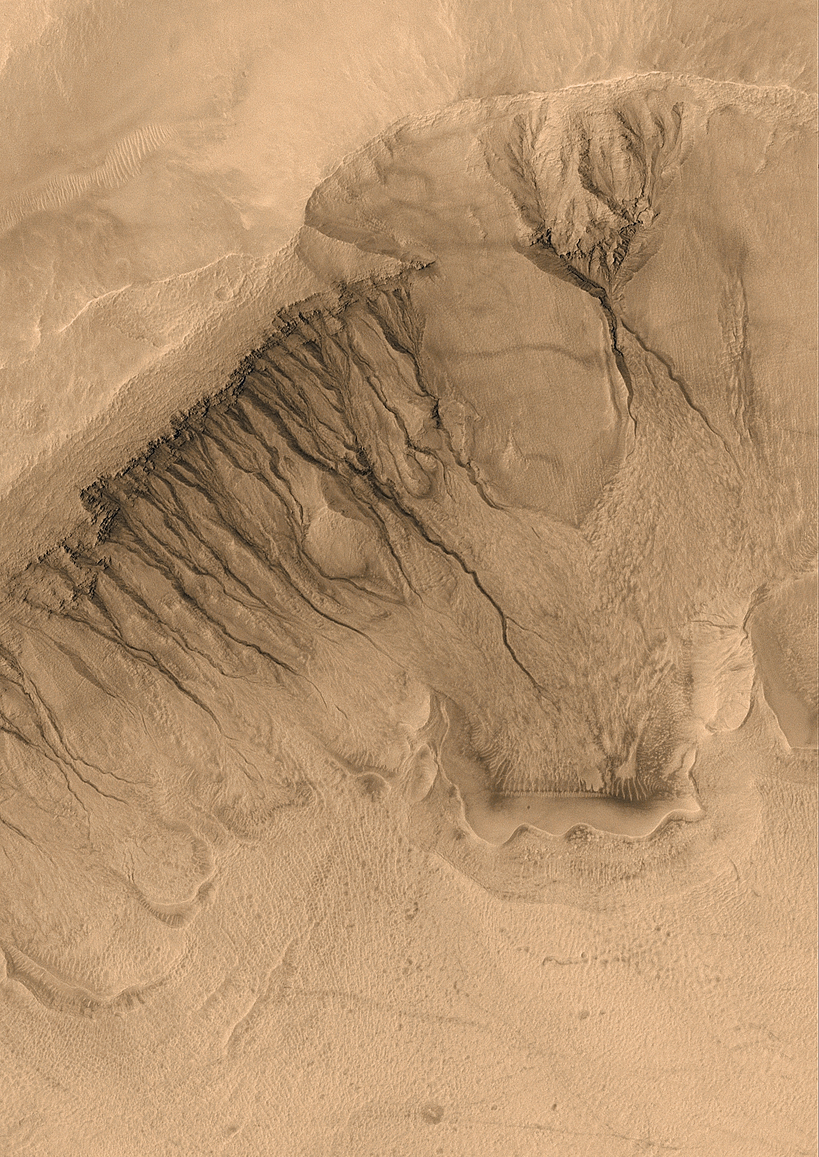
Image courtesy of
NASA/JPL/Malin Space Science Systems
(Click on the image below to load a MUCH larger version)
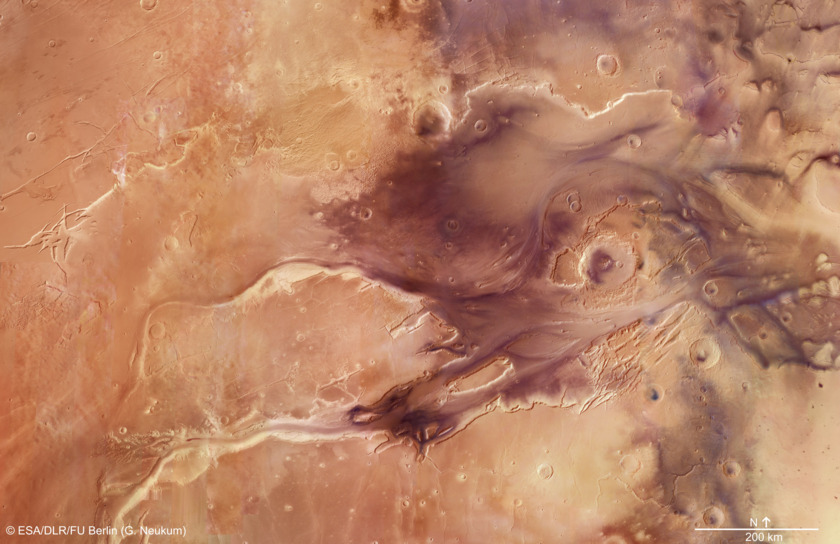
Image courtesy of
ESA / DLR / FU Berlin (G. Neukum)
The Ravi Vallis runs over 200 km across the surface. Long ago, some event (volcanic action? an impact?) at the left end of the valley melted a huge amount of icy material just below the ground, creating a sudden flood of water -- enough to fill Lake Superior. For several weeks, the water rushed across the landscape, from left to right in the image below, scouring the ground, digging a channel, and carrying debris with it. When the water reached the edge of the Xanthe Plateau (near the right edge of the picture above), it dropped over 3000 meters, in what must have been the most impressive waterfall in the Solar System at that time.
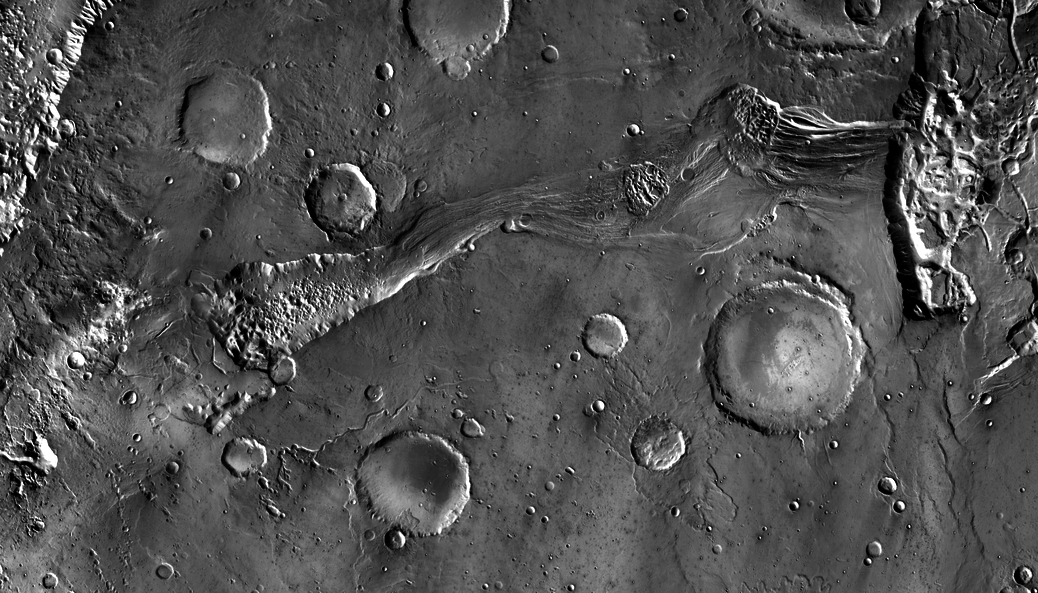
Image courtesy of
NASA/JPL-Caltech/Arizona State University
When did this particular flood occur? The answer is somewhat unclear. It's relatively easy to place the event into the proper geologic era: the Hesperian -- roughly in the "middle" of Mars' active phase. But figuring out the absolute age is more difficult. Somewhere between 3.0 and 3.7 billion years ago is a reasonable estimate, according to the Mars Odyssey THEMIS team.

Image courtesy of
Emily Lakdawalla
after Tanaka and Hartmann (2012)
Of course, most of these features are very, very old. They tell us that large amounts of liquid water were ONCE flowing across Mars ... but not necessarily where that water is now.
The final type of evidence that liquid water was once common on Mars comes from mineralogy. Several spacecraft have placed landers on the surface which can analyze samples of dirt, sand, and rock.
For example, the Mars Exploration Rovers, Opportunity and Spirit ...
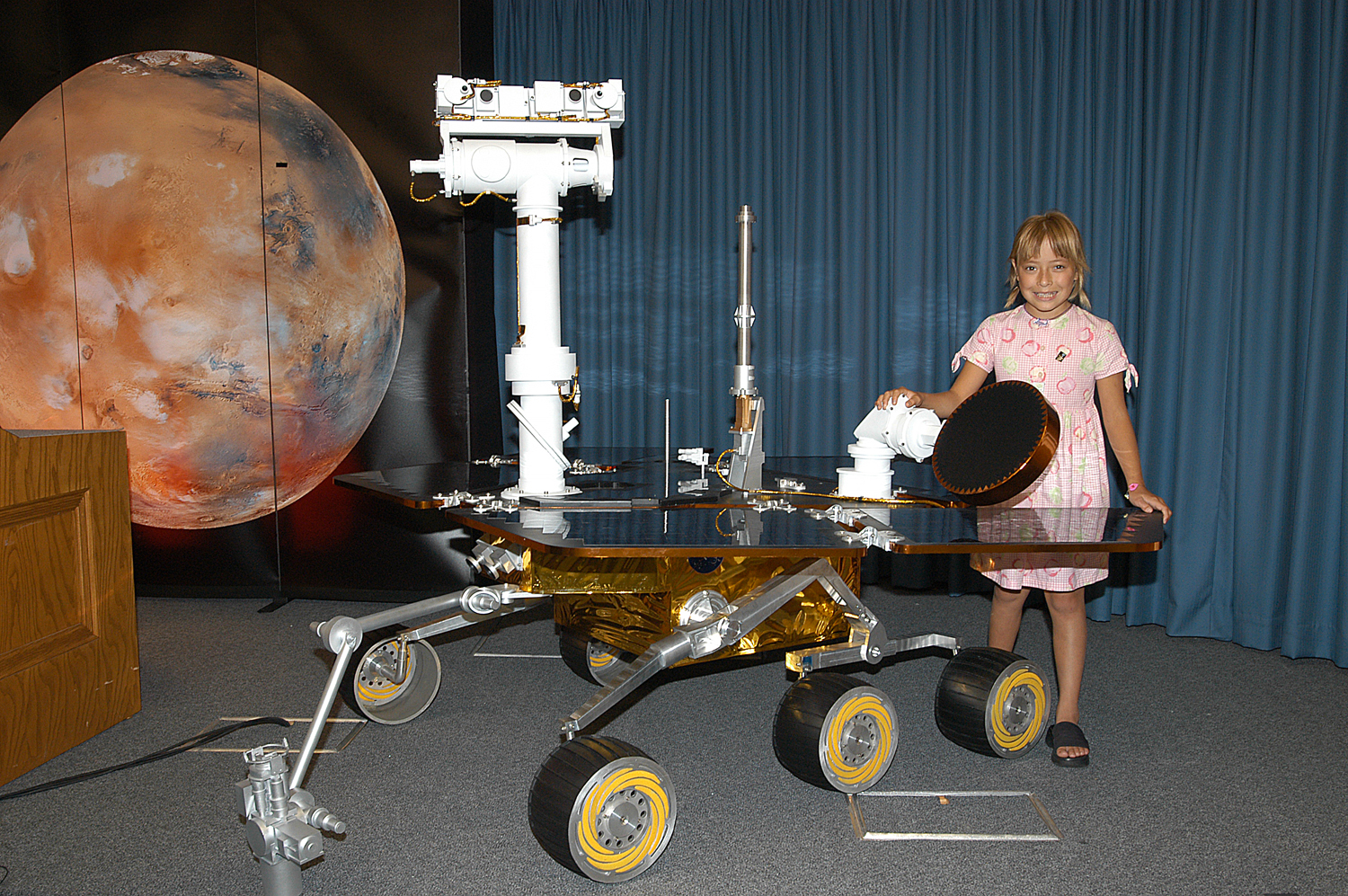
Image of Mars Exploration Rover model courtesy of
NASA/JPL
... and the Curiosity Rover, with a nuclear-powered drill (well, the entire rover is nuclear-powered, but it sounds cool).
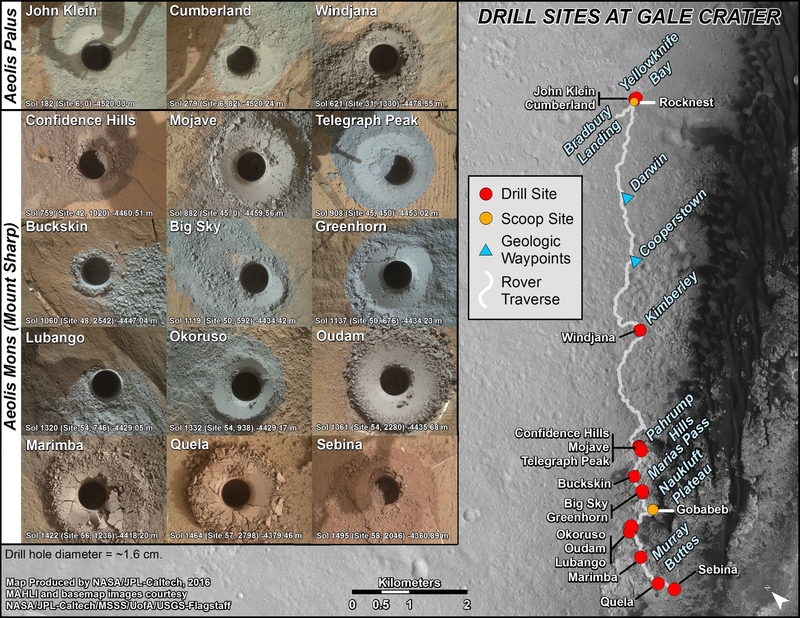
Image courtesy of
NASA/JPL-Caltech
The mini-laboratories aboard these rovers can measure the chemical properties of rocks and soils directly.
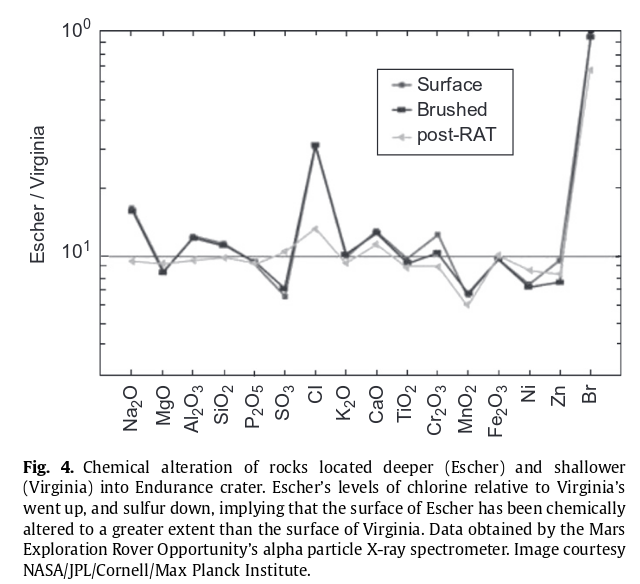
Figure 4 taken from
Fairen et al., Planetary and Space Science, 57, 276 (2009)
The presence of certain minerals, such as hematite, means that liquid water must have been present at the time of their formation.

Figure 6 taken from
Fairen et al., Planetary and Space Science, 57, 276 (2009)
Of course, just like the channels carved by flowing water, these minerals are evidence for liquid water LONG AGO, not right now.
So, is there any liquid water on Mars right now? Well, it's a bit hard to say. There have certainly been many announcements of evidence for liquid water on Mars over the years -- so many so that the authors of this article are careful to pump the brakes on the latest hype train:

Headlines taken from
a blog entry by Emily Lakdawalla
One of the most recent discoveries is based on radar measurements of a region near the South Pole of Mars:
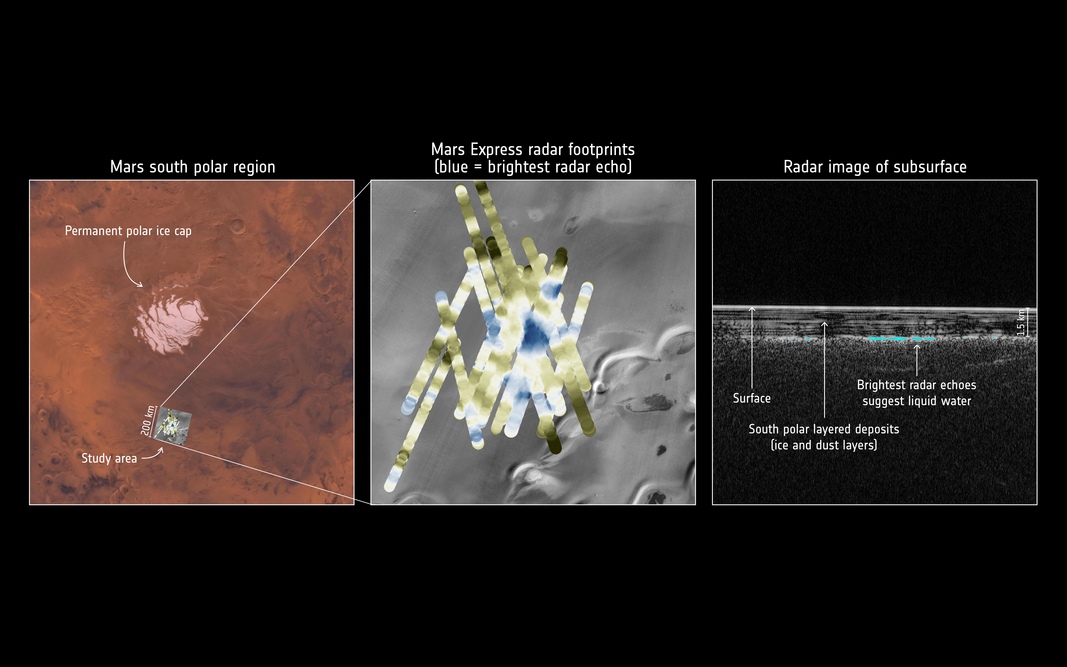
Context map: NASA/Viking; THEMIS background: NASA/JPL-Caltech/Arizona State University; MARSIS data: ESA/NASA/JPL/ASI/Univ. Rome; R. Orosei et al 2018
Why do we care so much about water on Mars? Two reasons:
At the current time, it seems that the creators of the Mars and Beyond, made back in 1957, may have been just a bit too optimistic.
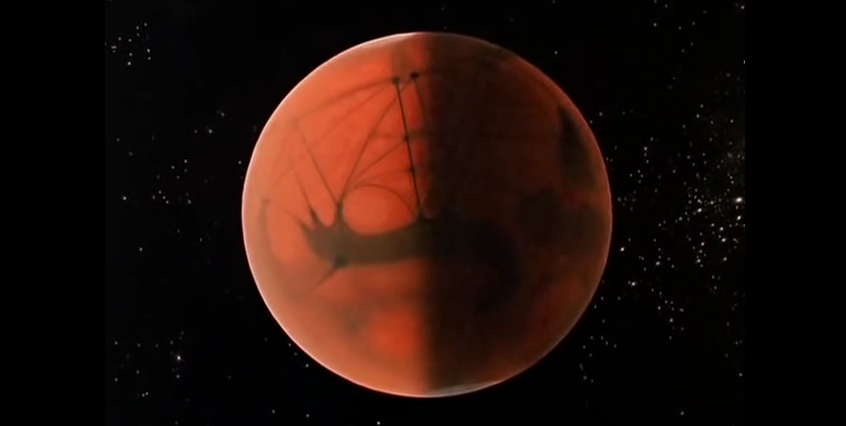
Still frame
taken
from
Walt Disney's "Mars and Beyond" (1957)
 Copyright © Michael Richmond.
This work is licensed under a Creative Commons License.
Copyright © Michael Richmond.
This work is licensed under a Creative Commons License.